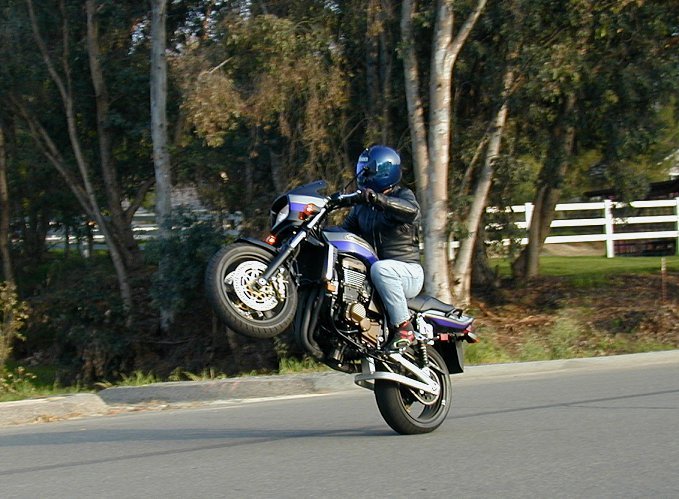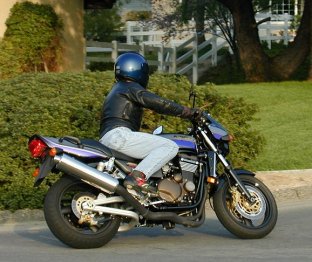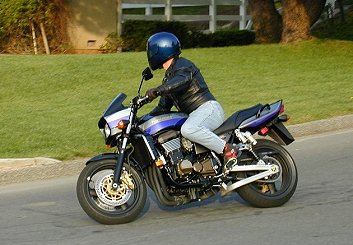
If you like naked bikes (or “standards”) you need to thank Europe for the selection available this year in the United States. Naked bikes are big business in Europe, and they have been for several years. I doubt Kawasaki would have built this test bike, the ZRX1200R, for the U.S. market. Europe has driven development in this area . . . and what development it has been.
The 2001 Kawasaki ZRX1200R is a fantastic motorcycle. The successor to the ZRX1100 (which was on Cycle World’s ten best list for 2000, and gathered other accolades) has been bored, stroked, tuned and tweaked to create a machine that is so entertaining, and performs so well, it is hard to believe that Kawasaki prices this machine at only $7,899.00 MSRP.
I need to explain something to you. I picked up the ZRX1200R from Kawasaki when I dropped off Kawasaki’s ZX-12R. When Kawasaki’s press rep told me I should be impressed by the motor in the ZRX1200R, I politely agreed and drove off expecting the bike to feel slow after riding perhaps the quickest accelerating street legal machine in the world. I was dead wrong.
The motor in the ZRX1200R is simply fantastic. Last year’s ZRX1100, with its retro “Eddie Lawson” styling, grunty motor and excellent handling for the class, spawned clubs and passion among not only Kawasaki fans but fans of naked bikes in general. Kawasaki has largely scrapped that design. Not that everything on the ZRX1200R is new, but there are very significant changes.
Last year’s motor has been bored and stroked to increase displacement by more than ten percent to 1164cc. Thank Europe again, because torque rules the naked bike class in Europe. The bigger the engine, the better. This wasn’t simply a bore and stroke job, however. The ZX-11 based, liquid cooled motor (far more modern than some of the air cooled or air/oil cooled motors in the class) has a new, lighter, all-aluminum cylinder block with electroplating (transfers heat more quickly so tighter tolerances can be utilized to generate more power), new crank shaft, and new cylinder head. The motor is fed by a bank of 36mm Keihin carburetors controlled by Kawasaki’s throttle-responsive ignition control (“K-TRIC”) throttle position sensor for better fuel economy and crisper throttle response.
A new four-into-one exhaust is made entirely of stainless steel, and California emission standards have been met without a power loss by including a pipe-like catalyzer in the exhaust system.

Kawasaki claims a 13% increase in power from “bottom to top”. The motor was so surprisingly strong that we quickly took it to the dynamometer. The dyno operator, North County Hypersports (760-722-TUNE) is an experienced race shop and tuner that knows its business. The big Kawasaki was strapped in, and, with a roll of the throttle beginning at 3,500 rpm (which is somewhat of a shame, because torque is huge as low as 3,000 rpm — see discussion below), the machine didn’t disappoint.
The ZRX1200R has very smooth power and torque curves that peak at 115.2 horsepower (at 8,300 rpm) and 84 foot pounds of torque (at 6,700 rpm). Moreover, the powerband is huge. The bike pulls very strong from 3,000 rpm (it will wheelie off the throttle — no clutch required — at that rpm) and pulls hard all the way through 9,000 rpm (where it is still making more than 110 horsepower at the rear wheel).
The motor is extremely smooth, and it makes you feel like a hero because you virtually have all of the power you need all of the time. Fantastic!
Last year’s ZRX1100 was praised for its handling, but Kawasaki didn’t rest on its laurels. Significant changes were made to the chassis to improve rigidity and handling. A new gusset behind the steering head improves rigidity and steering precision, while a new swingarm pivot location (5 mm lower than last year) and new, stiffer swingarm and wider rear-wheel all contribute to better handling.
The swingarm is the same retro-style over/under design, but is much beefier this year and provides the rigidity expected of a sportbike. The fine-tuning of the swingarm pivot point location is claimed to reduce chain-torque reaction, and provide better traction (along with the much needed 180-section rear tire).
Drive line lash is reduced with the use of a new eurothane rear-wheel damper bar from the ZX-12R.

For a big bike, and it is a big bike, the ZRX1200R handles exceptionally well. It’s suspension is not “budget bike suspension”, but fully adjustable (compression, rebound and spring preload) both front and rear. The 43mm cartridge forks provide good rigidity for the class.
The huge, 310mm front discs are clamped by opposed, six-piston calipers. The single rear disc is operated by an opposed twin piston caliper.
Fuel capacity is 5.3 gallons, and the ZRX features a gasoline gauge, along with the usual tachometer/speedometer/odometer and trip meter.
Performance wise, the ZRX1200 far exceeded my expectations. I cannot tell you how much the engine impressed me. It is rumored that Kawasaki spent the time and effort developing this engine not only for this motorcycle, but for a new sport tourer expected to arrive next model year. The motor combines huge thrust, smoothness and character — with an entertaining exhaust note. Peak horsepower is very high for a “tuned for torque” motor, and, particularly, for a motor with such a broad powerband.
The use of a five-speed gearbox is very reasonable on this bike. There is so much torque, over such a broad band, that six speeds would really be pointless. As it is, the rider simply leaves the bike in one gear most of the time, and rows the gearbox only when accelerating at maximum.
The rigid chassis and huge torque allow clutchless wheelies in first gear from 3,000 rpm onward, and the chassis balance is reflected in the fact that the bike is very balanced on the rear wheel and the smooth engine allows you to reach the balance point and stay there. (Of course, do not attempt wheelies if your experience and skill level make them dangerous, or your surroundings make them dangerous.)

The big ZRX is also very comfortable, with a relatively upright riding position and a small, but effective, fairing that keeps the wind blast off the chest at elevated speeds. The seat provided comfort not only for the rider, but for a passenger on a lengthy trip. The seat peg relationship is much more generous for a passenger than on hard-core sportbikes, for instance.
The ZRX is a “do it all” motorcycle. With a light and nimble feeling once underway, the bike is a blast around town, and a very effective freeway tool, as well. The bike also has a fluidity about its cornering that belies its size and naked bike status. The ZRX has to be pushed very hard, indeed, to show any signs of chassis flex. The beefed-up steering head and much stiffer swing arm must be credited here. The first place flex is noted is in the forks, and a fork brace would almost certainly eliminate this completely.
Style is a matter of personal taste but, in my opinion, the ZRX1200R is a handsome machine. It may have something to do with my age (early forties), but the shape, paint and gold anodized details all come together to please my eye. To get this style (early 80s superbike) with thoroughly modern engine and chassis performance is something that Kawasaki has had to build up to. From the air-cooled Zephyr models of ten years ago, to this latest evolution of the water-cooled ZRX, Kawasaki has come an awful long way.
Many people think that Kawasaki’s ZRX1200R will compete primarily with Yamaha’s new FZ-1 naked bike. I don’t really see it that way. First of all, the ZRX1200R has a much larger and torqueier motor. Yamaha’s own figures indicate that the FZ-1 has lower peak torque than its R-1, and the ZRX1200R already exceeds the peak torque of an R-1 over roughly a 5,000 rpm band. The ZRX1200R has a 17% larger motor, and it is a relatively modern design. The FZ-1 will probably have slightly higher peak horsepower at the rear wheel, but lack the effortless roll-on performance of the big ZRX. There really is no substitute for cubic inches (or cubic centimeters), particularly when comparing two relatively modern engine designs.
Handling wise, of course, I am not in a position to comment on the FZ-1. All I can say is that the ZRX1200R handles exceptionally well. The styling of the ZRX1200R (again, a matter of taste) is certainly more retro, and, overall, has a more detailed look (including the unique swingarm and gold anodized parts throughout). If you like stomp right above idle, and the retro style of the ZRX, you just can’t go wrong. This is a tremendous motorcycle at any price, and certainly at the U.S. MSRP of $7,899.00. Here is a link to Kawasaki’s website where you can take a look at all of the detailed specifications of the 2001 ZRX1200R.





